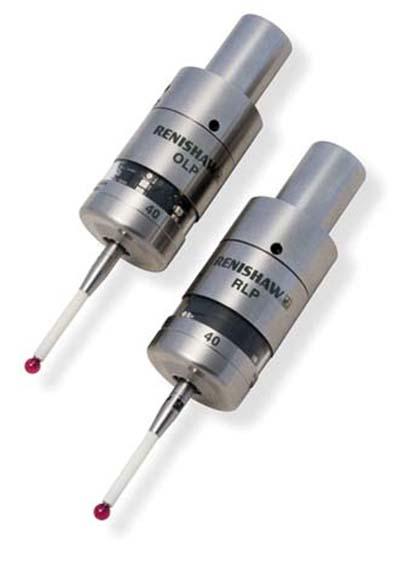
Renishaw's new RLP40 and OLP40 lathe inspection probes offer a choice of signal transmission technologies – radio or optical – to make part setup and inspection on turning centers accurate, simple and reliable. Measuring 40mm (1.57 in) in diameter and 58.3mm (2.30 in) long, the probes provide unidirectional repeatability of 1µm (0.00004") and can be used to reduce setup times, scrap and fixture costs, while improving process control. Both designs are hardened and sealed to IPX8 to withstand the extreme environments typical of lathes and turning centers. A proven eyelid protection system prevents entry of swarf and chips that could damage probe internals. The RLP40's frequency-hopping spread spectrum (FHSS) radio transmission pairs with the standard Renishaw Radio Machine Interface (RMI) and utilizes the 2.4GHz frequency band. The probe and its interface continually hop from one transmission channel to another, delivering signal robustness and flexibility through frequency switching. Radio transmission allows continuous communication between the probe and the interface, even when line-of-sight is lost. The OLP40 uses modulated optical transmission for high resistance to light interference, and its 360-degree transmission systems allows the probe to operate in any orientation. It also works with Renishaw's legacy transmission systems, while two touch probes can be used on one turning center when the OMI-2T interface unit is used. A range of shanks is available, including parallel and tapered designs, for flexibility when mounting the probes in a lathe or turning center turret. RMP40M and OMP40M "transmission-only" modules are also available to allow the use of Renishaw's LP2 family of touch probes and accessories to reach part features that would otherwise be inaccessible.
Contact Details
Related Glossary Terms
- bandsaw blade ( band)
bandsaw blade ( band)
Endless band, normally with serrated teeth, that serves as the cutting tool for cutoff or contour band machines.
- centers
centers
Cone-shaped pins that support a workpiece by one or two ends during machining. The centers fit into holes drilled in the workpiece ends. Centers that turn with the workpiece are called “live” centers; those that do not are called “dead” centers.
- fixture
fixture
Device, often made in-house, that holds a specific workpiece. See jig; modular fixturing.
- lathe
lathe
Turning machine capable of sawing, milling, grinding, gear-cutting, drilling, reaming, boring, threading, facing, chamfering, grooving, knurling, spinning, parting, necking, taper-cutting, and cam- and eccentric-cutting, as well as step- and straight-turning. Comes in a variety of forms, ranging from manual to semiautomatic to fully automatic, with major types being engine lathes, turning and contouring lathes, turret lathes and numerical-control lathes. The engine lathe consists of a headstock and spindle, tailstock, bed, carriage (complete with apron) and cross slides. Features include gear- (speed) and feed-selector levers, toolpost, compound rest, lead screw and reversing lead screw, threading dial and rapid-traverse lever. Special lathe types include through-the-spindle, camshaft and crankshaft, brake drum and rotor, spinning and gun-barrel machines. Toolroom and bench lathes are used for precision work; the former for tool-and-die work and similar tasks, the latter for small workpieces (instruments, watches), normally without a power feed. Models are typically designated according to their “swing,” or the largest-diameter workpiece that can be rotated; bed length, or the distance between centers; and horsepower generated. See turning machine.
- parallel
parallel
Strip or block of precision-ground stock used to elevate a workpiece, while keeping it parallel to the worktable, to prevent cutter/table contact.
- process control
process control
Method of monitoring a process. Relates to electronic hardware and instrumentation used in automated process control. See in-process gaging, inspection; SPC, statistical process control.
- swarf
swarf
Metal fines and grinding wheel particles generated during grinding.
- turning
turning
Workpiece is held in a chuck, mounted on a face plate or secured between centers and rotated while a cutting tool, normally a single-point tool, is fed into it along its periphery or across its end or face. Takes the form of straight turning (cutting along the periphery of the workpiece); taper turning (creating a taper); step turning (turning different-size diameters on the same work); chamfering (beveling an edge or shoulder); facing (cutting on an end); turning threads (usually external but can be internal); roughing (high-volume metal removal); and finishing (final light cuts). Performed on lathes, turning centers, chucking machines, automatic screw machines and similar machines.
